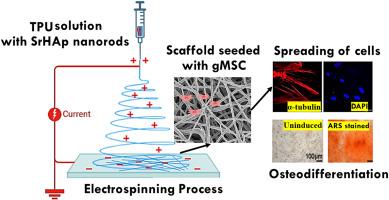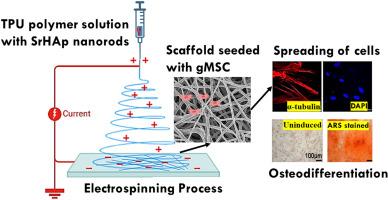掺锶羟基磷灰石纳米棒和热塑性聚氨酯弹性体电纺丝骨再生支架的研制
IF 4.5
2区 化学
Q2 POLYMER SCIENCE
引用次数: 0
摘要
锶基生物材料由于其令人难以置信的骨诱导能力和分化能力,在骨组织再生中具有重要意义。本研究采用共沉淀法合成了掺杂锶的羟基磷灰石纳米棒[SrHAp, Ca9Sr(PO4)6(OH)2]。随后,用分散在SrHAp纳米棒上的热塑性聚氨酯弹性体(TPU)制备电纺丝纤维支架。在2个步骤中,SrHAp纳米棒在TPU中的负载从1 wt.%变化到7 wt.%。利用场发射扫描电镜和能量色散x射线能谱分别表征了电纺丝纤维支架的形态和纳米棒在TPU基体中的分散。支架具有三维互联的网状结构,孔隙分布均匀。通过元素图谱和透射电镜观察到SrHAp纳米棒平滑地分散在支架的聚合物基质中。新开发的支架具有足够的机械强度,同时具有良好的生物相容性和良好的生物矿化特性。此外,通过MTT(3-(4,5-二甲基噻唑-2-基)-2,5-二苯基溴化四唑)试验,发现电纺丝支架对龈源间充质干细胞(gMSCs)具有良好的存活和生长速率。此外,利用gMSCs进行的骨诱导性研究通过显示碱性磷酸酶(ALP)、骨钙素(OCN)和RUNX2的表达,证实了含有5 wt.% SrHAp的支架比含有同类支架具有更好的骨分化能力。在所有组合物中,添加3wt .% SrHAp的组合物在纤维均匀性、改善机械性能和增强细胞活力方面表现出了令人满意的结果。因此,本研究开发的SrHAp/TPU支架具有用于骨组织再生的潜力。本文章由计算机程序翻译,如有差异,请以英文原文为准。


Development of electrospun scaffolds for bone regeneration from strontium-doped hydroxyapatite nanorods and thermoplastic polyurethane elastomer
Strontium based biomaterials have gained importance in bone tissue regeneration due to their incredible osteoinductivity and differentiation ability. In this study, strontium-doped hydroxyapatite nanorods [SrHAp, Ca9Sr(PO4)6(OH)2] were synthesized by the coprecipitation method. Subsequently, electrospun fibrous scaffolds were fabricated from thermoplastic polyurethane elastomer (TPU) dispersed with SrHAp nanorods. The loading of SrHAp nanorods in TPU was varied from 1 wt% to 7 wt% in steps of 2. Morphology of electrospun fibrous scaffolds and the dispersion of nanorods in the TPU matrix were characterised by field emission scanning electron microscopy, and elemental mapping by energy-dispersive x-ray spectroscopy, respectively. The scaffolds exhibited 3D interconnected network structure with well-distributed pores. The SrHAp nanorods were observed to be smoothly dispersed in the polymer matrix in the scaffolds using elemental mapping and transmission electron microscopy. The newly developed scaffolds exhibited adequate mechanical strength combined with good biocompatibility and excellent biomineralization characteristics. Further, MTT (3-(4,5-dimethylthiazol-2-yl)-2,5-diphenyltetrazolium bromide) assay of the electrospun scaffolds against gingiva-derived mesenchymal stem cells (gMSCs) revealed excellent survival and growth rate of the cells. In addition, the osteoinductivity study using gMSCs confirms the better osteodifferentiation in the scaffold containing 5 wt% SrHAp compared with its counterparts by showing the expressions of alkaline phosphatase (ALP), osteocalcin (OCN) and RUNX2. Among all the compositions, the one with 3 wt% SrHAp loading demonstrated promising results in terms of fiber uniformity, improved mechanical properties, and enhanced cell viability. Thus, the SrHAp/TPU scaffolds developed in this study have the potential for use in bone tissue regeneration.
求助全文
通过发布文献求助,成功后即可免费获取论文全文。
去求助
来源期刊

Polymer
化学-高分子科学
CiteScore
7.90
自引率
8.70%
发文量
959
审稿时长
32 days
期刊介绍:
Polymer is an interdisciplinary journal dedicated to publishing innovative and significant advances in Polymer Physics, Chemistry and Technology. We welcome submissions on polymer hybrids, nanocomposites, characterisation and self-assembly. Polymer also publishes work on the technological application of polymers in energy and optoelectronics.
The main scope is covered but not limited to the following core areas:
Polymer Materials
Nanocomposites and hybrid nanomaterials
Polymer blends, films, fibres, networks and porous materials
Physical Characterization
Characterisation, modelling and simulation* of molecular and materials properties in bulk, solution, and thin films
Polymer Engineering
Advanced multiscale processing methods
Polymer Synthesis, Modification and Self-assembly
Including designer polymer architectures, mechanisms and kinetics, and supramolecular polymerization
Technological Applications
Polymers for energy generation and storage
Polymer membranes for separation technology
Polymers for opto- and microelectronics.
 求助内容:
求助内容: 应助结果提醒方式:
应助结果提醒方式:


